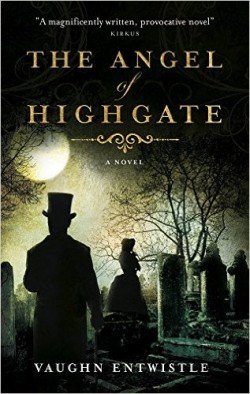Welcome to London! It is the autumn of 1859, and things get off with a bang as the central character appears to be having sex with a corpse inside a mausoleum in what would become the city’s most celebrated cemetery.
Highgate Cemetery is rapidly becoming the place to be seen dead. Lord Geoffrey Thraxton is rich, idle, debauched and has an unhealthy obsession with the dead of Highgate – both actual and feigned.
Our man dusts himself down after his interesting encounter on the tomb, and still has energy to pick a fight with a literary critic who has been scathing about his latest slim volume of poems. The hapless critic is called out for pistols at dawn, receives a bullet in the bum, and as a result we meet a sinister physician whose children all live in glass jars of formaldehyde. Dr Silas Garette treats Augustus Skinner – after a fashion – but cunningly makes certain that his patient becomes addicted to that celebrated drug of choice, laudanum.
You will have realised by this stage that the novel is a blend of stage melodrama and gothic horror. While the sets do not actually creak, we are treated to the full gamut of cliches, including seances, necrophilia (staged), opium dens (real), pale consumptive beauties, and cunning masters of disguise. This, and all the grave stones, and clouds scudding across the moon you can handle. Oh yes, and fog. Plenty of fog.
Lord Geoffrey becomes obsessed with a wraith-like figure who flits between the stone angels and memento mori of the cemetery. Is she real? Have his hours spent with the opium pipe addled his senses? Eventually he discovers that she is actual flesh and blood. Her name is Aurelia Greenley, and she is pale, fragile and possessed of an innocent beauty which the louche aristocrat finds irresistible. Meanwhile, Skinner, Garette and a trio of cuthroats (two of whom are improbably named Crynge and Snudge) plan Lord Geoffrey’s demise.
There are several grin-and-bear-it moments in the book. They whenever we encounter the ‘lower classes’. Servants, grave robbers, coachmen and ladies of the night all speak in a kind of mangled phonetic cockney, which is, presumably, intended to add authenticity to the dialogue. This doesn’t work in print. George Bernard Shaw didn’t manage it, either in Major Barbara or Pygmalion. I do wish writers would just trust readers to hear the voices in their own way.
When Aurelia is captured by Garette’s thugs, Thraxton and his old school chum, Algernon, are forced to stage a rescue attempt in the noisome back alleys and festering ruins of Seven Dials, the Victorian version of Obi-Wan Kenobi’s “wretched hive of scum and villainy”. Thanks to shotguns concealed in walking sticks, and the fact that they are both jolly good public school chaps, our brave pair manage to save Aurelia from a fate worse than death. Garette, however, is not yet bested and he plans a final and grisly revenge.
The concluding action happily leaves behind any sense of plausibility, and becomes more like the final volume of a Victorian penny dreadful. The book ends in a scene which is both strange and rather touching.
Despite all this, The Angel of Highgate is very entertaining. It clatters along the Victorian cobblestones at a fair old pace, and never allows us to get comfortable. Don’t read this book if you are a fan of finely nuanced psychological thrillers. If, however, you don’t mind a couple of hours of escapist entertainment, nourished by a bag of popcorn and a couple of beers, give it a try – it’s great fun!
The Angel of Highgate comes out 1 December. Click the links to read our reviews of earlier novels by Vaughn Entwistle – The Dead Assassin and The Revenant of Thraxton Hall.
Titan Books
Print/Kindle
£2.99
CFL Rating: 3 Stars









